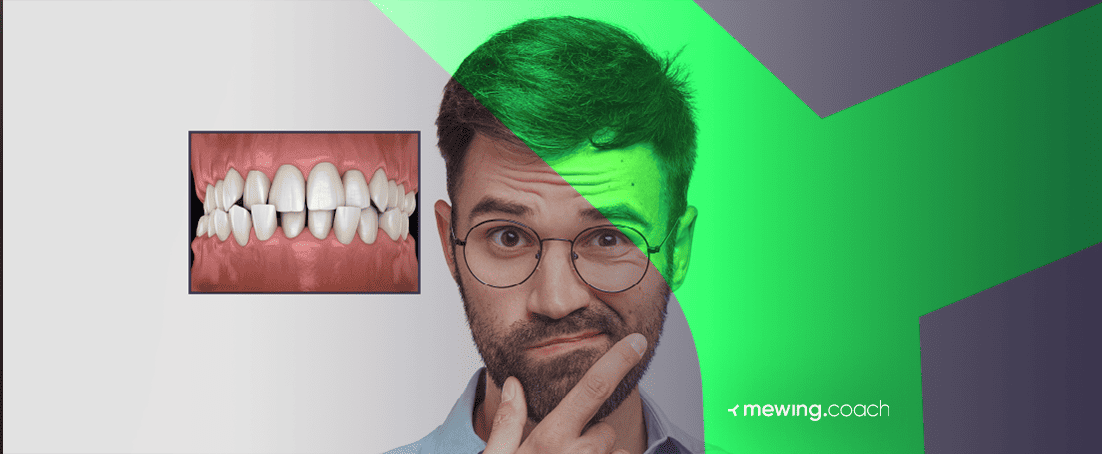Do you have crowded teeth? One reason for this might be crossbite. How can you fix it in an easy, non-surgical way? Simple – mewing!
Have you heard of the alternative orthodontic treatment that is popular on social media called mewing? Simply put, Mike Mew brought up the idea that the correct tongue placement can help reshape your jawline and help with various issues.
Aside from mewing with overbite, mewing for underbite, or even undergoing bruxism treatment with mewing, another common problem where this method is used is crossbite. This article will cover all you need to know about mewing and crossbite, including whether or not mewing may genuinely help you fix this issue.
On this page, you’ll read:
-
📝 A Simple Crossbite Definition: For those wondering what this problem is, we have it detailed all below!
-
👀 Why Crossbite Occurs: There are several common causes, so let’s see what these are!
-
📖 Mewing Crossbite Treatment: You need to know how mewing can help straighten teeth, so we offer an insight into the treatment.
-
💪 Before and After: Do you want to know if mewing truly helps? Let’s see the before and after effects.

What is Crossbite?
A dental condition known as a crossbite affects the alignment of your teeth. Sometimes it is called an underbite or bad bite.
When your mouth is closed, or at rest, the biggest indication that you have a crossbite is that your upper front teeth fit behind your lower teeth in your jaw position. Both your front and back teeth may be affected by this. There are two types of crossbites: anterior and posterior.
When the lower front teeth – the canines and the four incisors – protrude farther than the front upper teeth, this is known as an anterior crossbite. About 4-5% of people have anterior crossbites.
A posterior crossbite is when the bottom lower teeth – the premolars and molars – jut out farther than the upper bottom teeth. More prevalent posterior crossbites, which affect around 16% of the population, can also be treated with an expander or with jaw surgery.
Causes of Crossbite in Lower and Upper Jaw
Crossbites can occur due to various reasons – genetics, delayed loss of baby teeth, the abnormal eruption of permanent teeth, and even prolonged actions like thumb sucking or swallowing abnormally.
According to WebMD, crossbites can be caused by physical problems related to a person’s dental or skeletal structure, behaviors and habits, or sometimes both. These causes of crossbite may include:
-
early and continual sucking of finger, thumb, or pacifier
-
unnatural tongue movements whilst swallowing
-
missing, broken or crooked teeth
-
baby teeth that have failed to fall out
-
baby teeth that are crooked, or drift unnaturally pushing other teeth
-
insufficient jaw space for teeth to grow healthily, ie. small jaw
-
oversized teeth
-
cleft lip and palate
-
habitual mouth breathing starting from an early age
A study published by the Journal of American Dental Association shows that adolescents suffering from crossbites can benefit from an orthodontic intervention. However, before it comes to this, there is no reason why people shouldn’t try a simple way that requires no surgery – mewing.
What Age Should You Check and Fix a Crossbite?
The dental community is divided on when therapy for a crossbite should begin. Some people think that therapy needs to begin as soon as a crossbite is discovered (can be as early as three years old). Others believe that therapy should not begin until the child’s sixth-year molars appear.
While there is disagreement on the ideal time to treat a crossbite, everyone agrees that treatment is necessary. When left untreated, crossbites can result in several other issues, including tooth and gum wear and uneven jaw development, leading to temporomandibular joint disease.
Crossbite Treatment With Mewing
You might be asking yourself, why mewing? Why not just go for jaw surgery? Simple – you can do mewing any time, all for free!
Let’s start with the fact that there is mewing scientific evidence backing our claims. Mewing helps to enlarge and accentuate the jaw and jawline, which gives your upper jaw and lower teeth room to straighten. It also frequently lessens crowding without the need for invasive medical operations.
How should you do it? It’s all in the lip and tongue position. You can check our post on how mewing is done the right way so that you can have the best outcomes possible!
There are various benefits of mewing – from improved breathing to teeth alignment and even reduced pain in your upper and lower teeth. It’s usually advised to practice any mewing exercise for around half an hour to get the best results.
And the best part about this treatment plan is that you can do it any time, all for free!
With our Mewing.Coach app, you have no need for equipment and can do it even at home. All the best information on how to achieve the best mewing results can be right in your pocket!
Mewing Crossbite Results: Before and After Crossbite
Yes, mewing and straightening teeth can go hand in hand. Some of our clients report that with this treatment, they get a more defined chin in about a month. Other more severe cases say that 2.5 weeks is their needed time frame.
But aside from improving dental health, our satisfied customers report improved self-esteem and oral posture progress. See below the testimonials and the positive results from the users.
How Long Does It Take to Get Rid of Crossbite While Mewing?
Mewing can work faster in children than it does in adults. Children may begin to notice a lot of advantages from mewing 3 to 6 months after beginning the practice, while other people may experience effects as soon as the very next day.
Adults will have a somewhat more difficult time with mewing because it will take longer to see major effects. Due to these circumstances, you should expect to see truly remarkable results anywhere between 6 months and around 2 years.
But don’t get discouraged – sometimes beneficial effects may be noticed as soon as 24 hours. It’s all about perseverance and “teaching” yourself how should your teeth rest.
How to Prevent Crossbite Recurrence
“Does mewing work with braces?” Of course, it does! But don’t let your guard down – crossbites may reappear. So how can you stop crossbite from happening again? The simple answer is by continuously doing mewing work. However, you should also try and avoid the most common mewing mistakes, like touching your upper teeth with your tongue.
Other Crossbite Treatments for Upper and Lower Teeth
Orthodontics, including alternatives like braces or clear aligners, are another type of crossbite treatment. Surgery may occasionally be required, especially in severe cases. To shorten the lower jaw, put the upper jaw forward and enable optimal tooth alignment, a maxillofacial surgeon performs this orthognathic operation.
Aside from these, other methods include:
-
Palatal Expanders
-
Headgear
-
Tooth Removal
-
Dental Restorations





